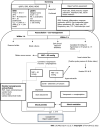Extracorporeal blood purification strategies in sepsis and septic shock: An insight into recent advancements
- PMID: 37034019
- PMCID: PMC10075046
- DOI: 10.5492/wjccm.v12.i2.71
Extracorporeal blood purification strategies in sepsis and septic shock: An insight into recent advancements
Abstract
Background: Despite various therapies to treat sepsis, it is one of the leading causes of mortality in the intensive care unit patients globally. Knowledge about the pathophysiology of sepsis has sparked interest in extracorporeal therapies (ECT) which are intended to balance the dysregulation of the immune system by removing excessive levels of inflammatory mediators.
Aim: To review recent data on the use of ECT in sepsis and to assess their effects on various inflammatory and clinical outcomes.
Methods: In this review, an extensive English literature search was conducted from the last two decades to identify the use of ECT in sepsis. A total of 68 articles from peer-reviewed and indexed journals were selected excluding publications with only abstracts.
Results: Results showed that ECT techniques such as high-volume hemofiltration, coupled plasma adsorption/filtration, resin or polymer adsorbers, and CytoSorb® are emerging as adjunct therapies to improve hemodynamic stability in sepsis. CytoSorb® has the most published data in regard to the use in the field of septic shock with reports on improved survival rates and lowered sequential organ failure assessment scores, lactate levels, total leucocyte count, platelet count, interleukin- IL-6, IL-10, and TNF levels.
Conclusion: Clinical acceptance of ECT in sepsis and septic shock is currently still limited due to a lack of large random clinical trials. In addition to patient-tailored therapies, future research developments with therapies targeting the cellular level of the immune response are expected.
Keywords: CytoSorb®; Extracorporeal therapies; Hemadsorbers; Inflammatory mediators; Sepsis.
©The Author(s) 2023. Published by Baishideng Publishing Group Inc. All rights reserved.
Conflict of interest statement
Conflict-of-interest statement: All the authors declare no conflict of interest.
Figures



References
-
- Singer M, Deutschman CS, Seymour CW, Shankar-Hari M, Annane D, Bauer M, Bellomo R, Bernard GR, Chiche JD, Coopersmith CM, Hotchkiss RS, Levy MM, Marshall JC, Martin GS, Opal SM, Rubenfeld GD, van der Poll T, Vincent JL, Angus DC. The Third International Consensus Definitions for Sepsis and Septic Shock (Sepsis-3) JAMA. 2016;315:801–810. - PMC - PubMed
-
- Organization WH. Global report on the epidemiology and burden of sepsis: current evidence, identifying gaps and future directions [Internet]. World Health Organization; 2020. Available from: https://apps.who.int/iris/handle/10665/334216 .
-
- Rudd KE, Johnson SC, Agesa KM, Shackelford KA, Tsoi D, Kievlan DR, Colombara DV, Ikuta KS, Kissoon N, Finfer S, Fleischmann-Struzek C, Machado FR, Reinhart KK, Rowan K, Seymour CW, Watson RS, West TE, Marinho F, Hay SI, Lozano R, Lopez AD, Angus DC, Murray CJL, Naghavi M. Global, regional, and national sepsis incidence and mortality, 1990-2017: analysis for the Global Burden of Disease Study. Lancet. 2020;395:200–211. - PMC - PubMed
-
- Torio CM, Andrews RM. National Inpatient Hospital Costs: The Most Expensive Conditions by Payer, 2011. In: Healthcare Cost and Utilization Project (HCUP) Statistical Briefs [Internet]. Rockville (MD): Agency for Healthcare Research and Quality (US); 2006 Feb- - PubMed
-
- Vincent JL, Sakr Y, Sprung CL, Ranieri VM, Reinhart K, Gerlach H, Moreno R, Carlet J, Le Gall JR, Payen D Sepsis Occurrence in Acutely Ill Patients Investigators. Sepsis in European intensive care units: results of the SOAP study. Crit Care Med. 2006;34:344–353. - PubMed
Publication types
LinkOut - more resources
Full Text Sources

